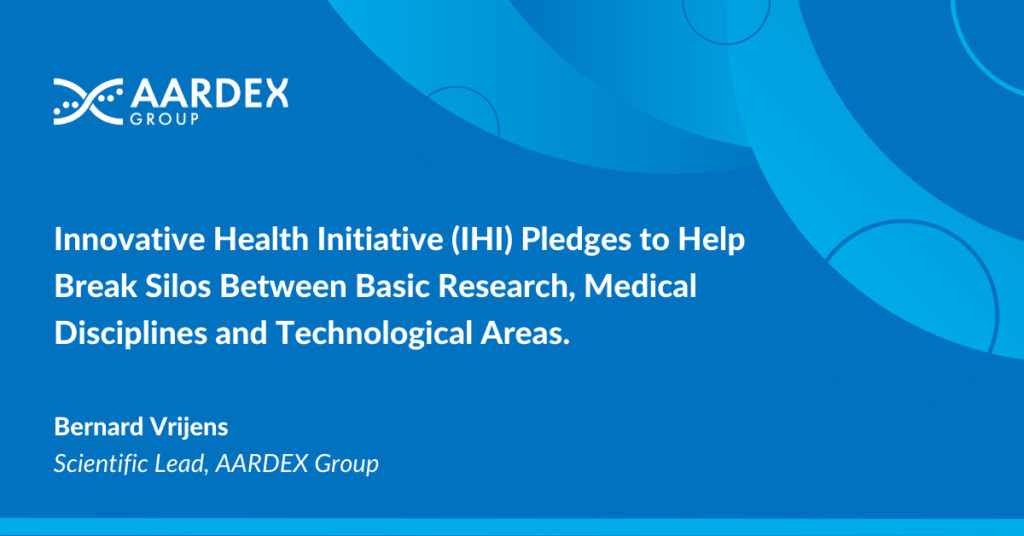Technology presents the healthcare community with a golden opportunity to improve lives – but only if we embrace that potential. Success, according to the Innovative Health Initiative’s Strategic Research and Innovation Agenda, depends on cross-sector collaboration.
Across Europe, healthcare faces a multitude of challenges. The region is home to an aging population, living with a rising number of expensive to treat co-morbidities.
At the same time, budgets are tight. In 2017, before the advent of COVID-19, healthcare expenditure accounted for almost 10% of the European Union’s (EU) gross domestic product (GDP).1
According to the Innovative Health Initiative’s (IHI) Strategic Research and Innovation Agenda, this “challenges the long-term sustainability of EU health care systems”, which are under increasing fiscal and organizational pressures.
The initiative, which aims to support the delivery of timely and well-substantiated prevention, diagnosis, and treatment, argues that while technology could help overcome these challenges, adoption is slow.
“A significant contribution to addressing the challenges in healthcare comes from innovative interventions that facilitate patient access to health care across the EU,” said the authors of the strategic research and innovation agenda.
“However, such interventions are notoriously complex to design and even more so to implement, as they may stretch over the full spectrum of the healthcare pathway: from prevention through diagnosis and treatment, through to disease management including long-term and palliative care.”
Solutions, they explain, cover a whole range of technologies, from medicinal products, medical devices, and in-vitrodiagnostics to digital technologies with artificial intelligence, robotics, and nanotechnologies.
Pool expertise across sectors and care disciplines and ensuring technologies meet the needs of those who use them is essential, the report goes on.
“The goal is a more targeted intervention strategy leading to personalized treatments and improved individual health outcomes,” it says. “To fully exploit the potential of various technologies and approaches, existing silos must be broken down across discovery science and translational research as well as between different academic research disciplines and industry sectors.”
Case in Point: Barriers to Medication Adherence
One barrier to effective care highlighted by the report is medication adherence – because it doesn’t matter how advanced medicine is, it is next to useless if the patient does not take it as prescribed.
Medication adherence to prescribed medications is notoriously poor, particularly in chronic diseases where WHO has estimated that 50% of patients do not take their medications as prescribed.
In the EU, the problem is associated with almost 200,000 deaths and €80- €125billion in costs every year.3
Despite the magnitude of the issue, poor medication adherence has remained the elephant in the room, largely due to a lack of effective solutions. Traditional methods of monitoring medicine-taking behavior, such as pill counts or self-report, are subjective and open to bias.
But, as the IHI strategy points out, new, integrated technological solutions hold the potential to finally solve a problem like patient adherence.
AARDEX’s Medication Adherence Tools, combine smart packaging that records dose administration and transmits the information to the healthcare team via AARDEX’s digital medication adherence platform.
Connected pre-filled syringes, smart pill bottles, or smart blister packs can, for example, collect essential information such as the time and date the injection was completed, or the tablet removed from the package or bottle, the type of drug, batch number, and expiration date.
This information is sent on to a cloud-based platform for analysis. Health teams are then presented with focused feedback that enables healthcare teams to identify patients that need additional support, faster.
Cross-sectorial focus
Like many digital health and MedTech interventions, then, digital adherence monitoring straddles disciplines and sectors – and success relies on making sure all parties are heading in the same direction.
The IHI understands this need for a multidisciplinary approach and has said it will focus on “cross-sectoral approaches”, and pledges to “help break silos between basic research, medical disciplines and technological areas”.
One of its “specific objectives” promises to “integrate fragmented health R&I efforts, bringing together health industry sectors and other stakeholders, focusing on unmet public health needs, to enable the development of tools, data, platforms, technologies, and processes for improved prediction, prevention, interception, diagnosis, treatment and management of diseases”.
IHI may also, it goes on, help to address the regulatory challenges related to products that combine different technologies and services by providing a platform for all stakeholders to share their views and experiences on issues such as the harmonization of approaches and evidence generation across sectors.
Towards a Healthier Europe
Europe provides some of the best healthcare in the world and is a leader in vaccine and drug discovery, medical technology, and digital health care solutions.
The time has come, the strategy says, to reap the benefits of such innovation along the entire health care spectrum – and designing tangible solutions needs input from all stakeholders.
At AARDEX, where all our digital solutions to manage patient adherence are fully validated and evidence-based, we welcome this approach.
No matter where you work in the healthcare business, whether you are in clinical care in Estonia or part of a Belgium SME like ours, we all have the same objective: to improve the lives and the outcomes of the people we serve.
By driving multi-sector collaboration to accelerate the development of citizen-centered healthcare innovations for areas of unmet health need, the IHI presents a unique opportunity for us all to achieve that goal.
References
- Innovative Health Initiative. (2020). Strategic Research and Innovation Agenda. Available at: https://www.ihi.europa.eu/sites/default/files/flmngr/IHI-GB-DEC-2022-XX_%20Annex%20Decision_SRIA_1.pdfLast accessed 23rd February 2022
- Kim, J., Combs, K., Downs, J., & Tillman, F. (2018). Medication adherence: The elephant in the room. US Pharm, 43(1), 30-34. https://www.uspharmacist.com/article/medication-adherence-the-elephant-in-the-room
- Van Boven, J. F., Tsiligianni, I., Potočnjak, I., Mihajlović, J., Dima, A. L., Nabergoj Makovec, U., … & Wettermark, B. (2021). European Network to Advance Best Practices and Technology on Medication Adherence: Mission Statement. Frontiers in pharmacology, 2620. https://www.frontiersin.org/articles/10.3389/fphar.2021.748702/full



